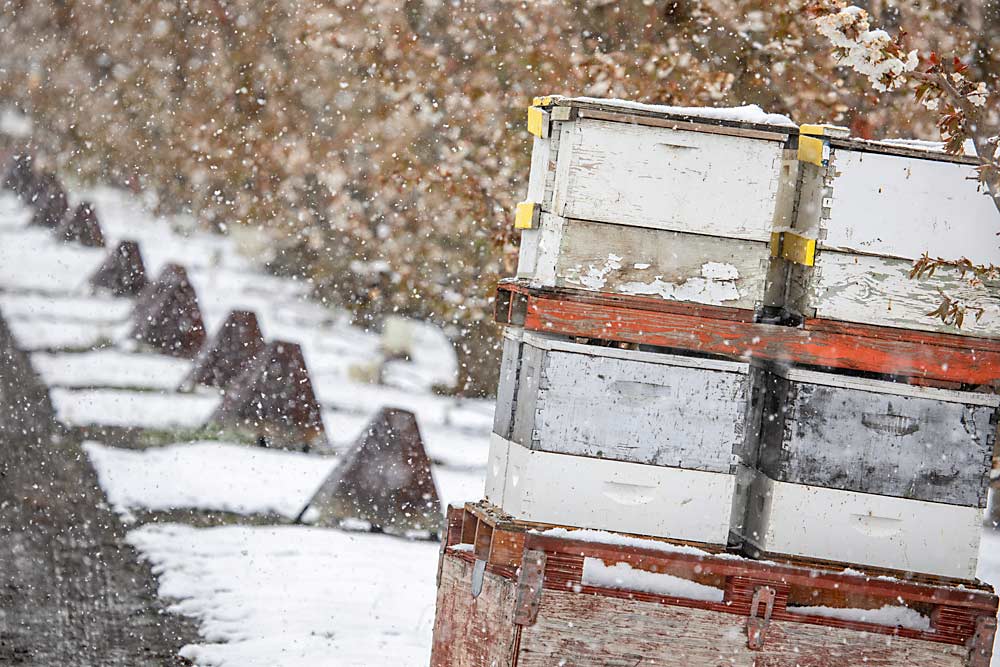
Washington growers and researchers have a few hard-learned lessons to carry with them from 2022 as they prepare for this year’s bloom.
Some growers might choose to chemical thin more conservatively. Poor pollination can lead to cracked apples. Alternative pollinators such as mason bees may offer an advantage.
April 2022 was a disastrous anomaly for Northwest fruit pollination: Honey bees stayed in their colonies, propane became a scarce commodity and photos of snow-covered blossoms are hard to forget. The cherry crop was just a fraction of normal.
Mother Nature can throw a curve ball at any time, leaving growers with few options other than “just hope it doesn’t happen again,” said Tim Pitz, orchard manager for Mount Adams Fruit orchards near White Salmon.
However, a few common themes emerged from last year’s wreckage that may inform 2023’s pollination season and an uncertain future.
Resilience
Matt Whiting, a Washington State University physiologist, suggests first looking at the big picture, seeking ways to build resilience into orchard systems and farming overall.
Some climate experts predict weather will become even more erratic over time, delivering shocks such as April snowstorms, heat domes and heavy rains (think about the recent California flooding) more often. The industry should take that into account when engineering netting systems, breeding new varieties or laying out orchards, he said. For example, water supplies may need to be secured for early spring frost protection.
Whiting himself is involved in startups that sell a sprayable pollen slurry to augment bee activity and a cellulose-based frost coating for tender buds.
He’s looking for growers to host trials of the not-yet-commercialized coating this spring. The tough spring of 2022 just reiterates the need for investment in risk management, he said.
“Just revisit your whole process,” he said.
Thin conservatively
Pitz of Mount Adams plans to lighten up on the lime sulfur for his organic Honeycrisp blocks this year — perhaps.
In 2022, he thought he was applying chemical thinners conservatively, but he also was trying to avoid biennial bearing. In hindsight, he probably could have waited a little longer, he said.
“I probably could have done nothing,” he said.
Some of his apple blocks turned out fine, bearing good crops. Others fell short due to poor fruit set.
As for his Regina cherry blocks, some blocks had poor sets while others yielded a hearty 10 tons per acre. For those lighter-setting locations, he wonders if a second application of plant growth regulators may have helped extend the viability of flower ovules.
Whiting doubted that; cold weather itself slows down ovule senescence. PGRs usually help more in warm weather, when ovules would otherwise senesce so quickly the odds of a bee reaching the flower in time go down.
Mount Adams crews typically puff supplemental pollen to Anjou pears and Regina cherries, but they did the same to Bosc and Bartlett last year due to weather. Pitz saw a slight bump in Bosc fruit set, while Bartlett blocks set a normal crop. He didn’t leave control blocks to substantiate the results, but other growers have convinced him to continue pollen applications on all those varieties when it’s cold in the future.
If anything, the pollination season reinforced his theory that pear orchard layouts need to change. They’re often designed with varieties in alternating rows — typically a 2-4-2 pattern — for harvest efficiency, not pollination. But bees prefer to fly down rows, not across them. His company has begun grafting pollination-specific varieties, such as Easter Beurre and Asian pears, within rows, mostly in Anjou blocks. New plantings get the same treatment.
Cracking in WA 38
By the time the 2022 season reached apple harvest, growers noticed more calyx cracking than usual on the WA 38, WSU’s apple marketed as Cosmic Crisp, as well as other varieties. Researchers mostly blamed this on April’s frost damage but haven’t completely established a cause-and-effect relationship, Whiting said.
“I consider it a major problem,” said Frank Lyall, a Grandview-area grower. He has seen some cracking the past two years, but in 2022 it diverted 95 percent of his WA 38 crop to processing, even though he still harvested 50–60 bins per acre. He knows of other orchards with similar results.
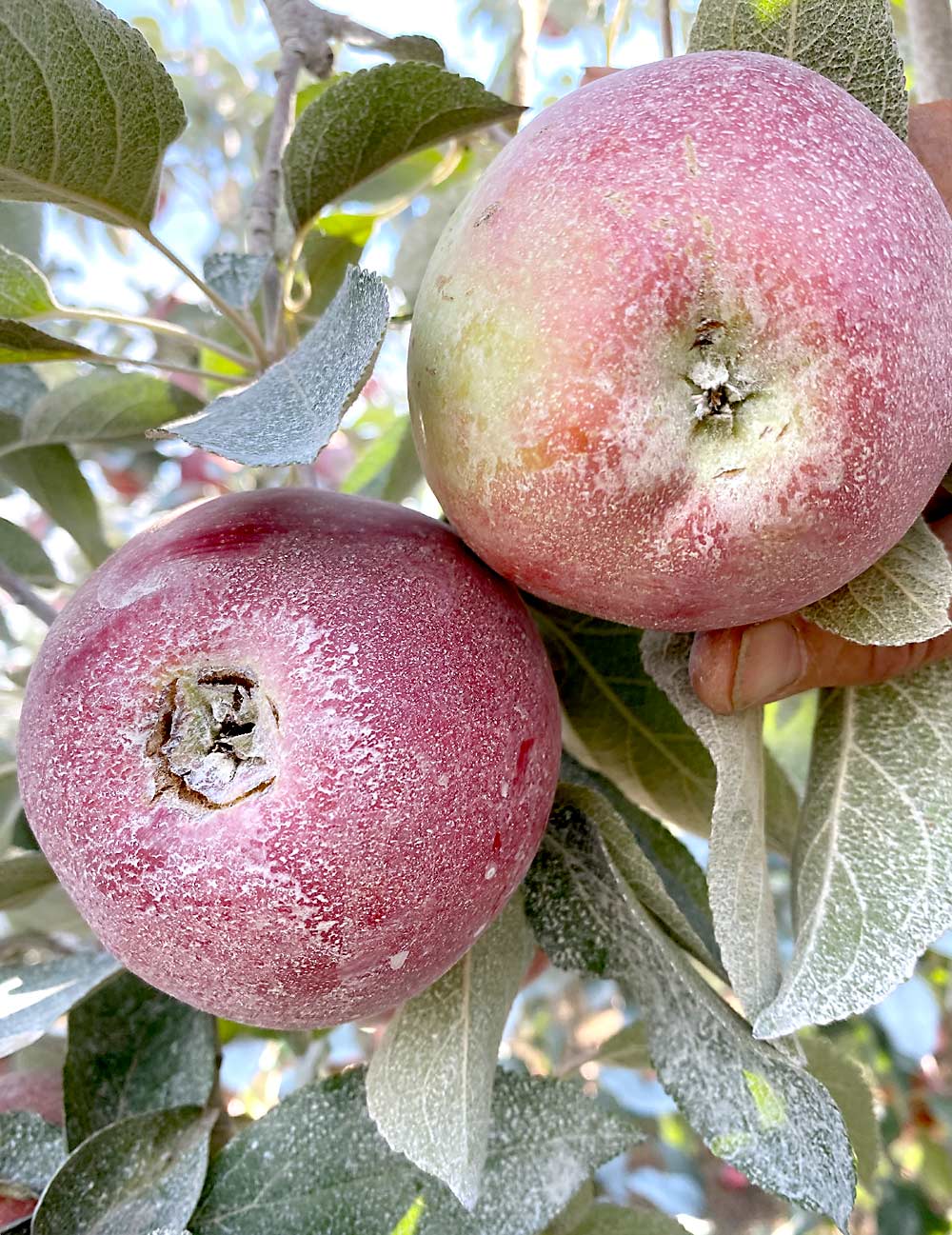
Last year, Del Monte Foods purchased culled WA 38 apples straight from orchards for the first time, using them in sauces and slice packs, said Steve Carlson, field manager for the Yakima processor. The Lower Yakima Valley, southeast of Yakima, seemed to be the only area affected, he said. The processor did not purchase WA 38 orchard culls from anywhere else in the state.
Processor apple prices were relatively high in the fall, he said.
Conclusions are elusive, Carlson said. The WA 38 is still new. Two hot summers may have played a role as much as a cool spring.
“I think it’s anybody’s guess,” Carlson said.
Researchers at WSU and the Washington Tree Fruit Research Commission attribute the calyx cracking primarily to cold damage during early flower development. At times, severity seemed to be higher toward the bottom of trees, according to an October article posted on the university’s tree fruit website. (For more information, visit: bit.ly/cosmic-crisp-2022.)
Bernardita Sallato, a WSU tree fruit extension specialist, said she saw different types of cracking in all the WA 38 blocks she checked, to varying degrees. Some were calyx-end cracks, attributed to spring frost, while other cracks and splits were caused by the combination of a cool spring and hot summer. She recommends growers monitor areas of high risk for frost, plan for extreme weather and deploy frost protection techniques as needed.
Mason bees may help
One Prosser-area cherry grower thinks mason bees may have helped him.
Brad Klingele harvested a healthy crop, especially compared to neighbors with similar cultivars and similar timing who didn’t harvest at all — unless their insurance companies required it.
His reasoning is far from scientific, he admitted. About 10 years ago, he released some mason bees — a solitary pollinator known for flying in colder weather than honey bees — in steep, undeveloped canyons neighboring his orchard. He provided bundles of straw to encourage their nesting but never tried to recapture the cocoons, as some growers do, or otherwise check on their well-being. Each year, he noticed a few flying in the spring, but he figured it wasn’t enough to make much difference for fruit set.
However, in April 2022, with daytime highs in the mid-40s to mid-50s, his father insists he saw bees working flowers. Honey bees typically don’t fly below 55 degrees Fahrenheit.
“Over the years, I think they have established,” Klingele said.
He now has some bumble bees on their way, though he placed that order before April 2022.
Lisa Acevas, a manager for Campbell Orchards near Tieton, has used mason bees in a cold, windy apricot block for several years now. She is happy with the results and has noticed a general increase in production over time, but not last year. It was just too cold.
“I can’t really compare it to anything,” she said.
—by Ross Courtney

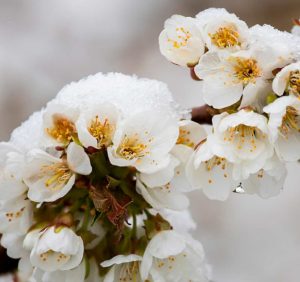
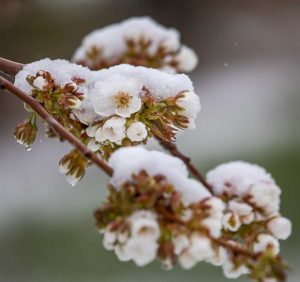
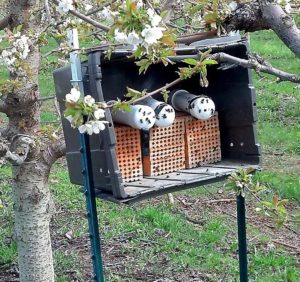
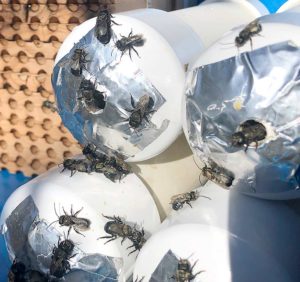





Leave A Comment